Application of ACS Code of Ethics in Solving an Ethical Dilemma
VerifiedAdded on 2023/04/23
|18
|2592
|323
AI Summary
This report outlines how to deal with an ethical dilemma using the ACS code of ethics and professional conduct. It also outlines the Australian code of ethics and conduct that apply to the case study. The report applies Chris MacDonald’s Methodology of professional ethics and conduct in the demonstration of how to analyze and resolve the ethical dilemma.
Contribute Materials
Your contribution can guide someone’s learning journey. Share your
documents today.

Running Head: Assignment 1 1
IT WRITE UP
STUDENT’S NAME
COURSE
UNIVERSITY
DATE
IT WRITE UP
STUDENT’S NAME
COURSE
UNIVERSITY
DATE
Secure Best Marks with AI Grader
Need help grading? Try our AI Grader for instant feedback on your assignments.
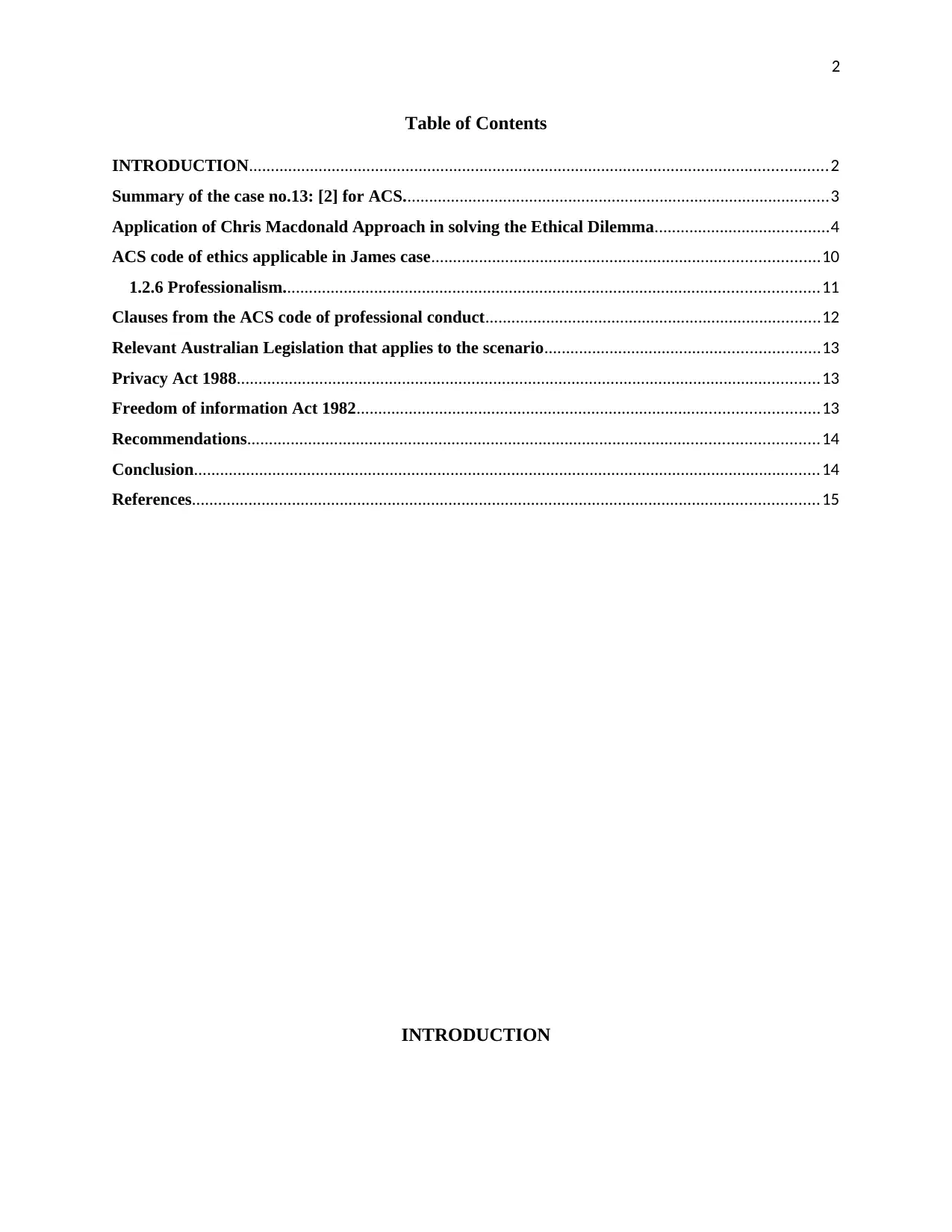
2
Table of Contents
INTRODUCTION.....................................................................................................................................2
Summary of the case no.13: [2] for ACS..................................................................................................3
Application of Chris Macdonald Approach in solving the Ethical Dilemma........................................4
ACS code of ethics applicable in James case.........................................................................................10
1.2.6 Professionalism...........................................................................................................................11
Clauses from the ACS code of professional conduct.............................................................................12
Relevant Australian Legislation that applies to the scenario...............................................................13
Privacy Act 1988......................................................................................................................................13
Freedom of information Act 1982..........................................................................................................13
Recommendations...................................................................................................................................14
Conclusion................................................................................................................................................14
References................................................................................................................................................15
INTRODUCTION
Table of Contents
INTRODUCTION.....................................................................................................................................2
Summary of the case no.13: [2] for ACS..................................................................................................3
Application of Chris Macdonald Approach in solving the Ethical Dilemma........................................4
ACS code of ethics applicable in James case.........................................................................................10
1.2.6 Professionalism...........................................................................................................................11
Clauses from the ACS code of professional conduct.............................................................................12
Relevant Australian Legislation that applies to the scenario...............................................................13
Privacy Act 1988......................................................................................................................................13
Freedom of information Act 1982..........................................................................................................13
Recommendations...................................................................................................................................14
Conclusion................................................................................................................................................14
References................................................................................................................................................15
INTRODUCTION
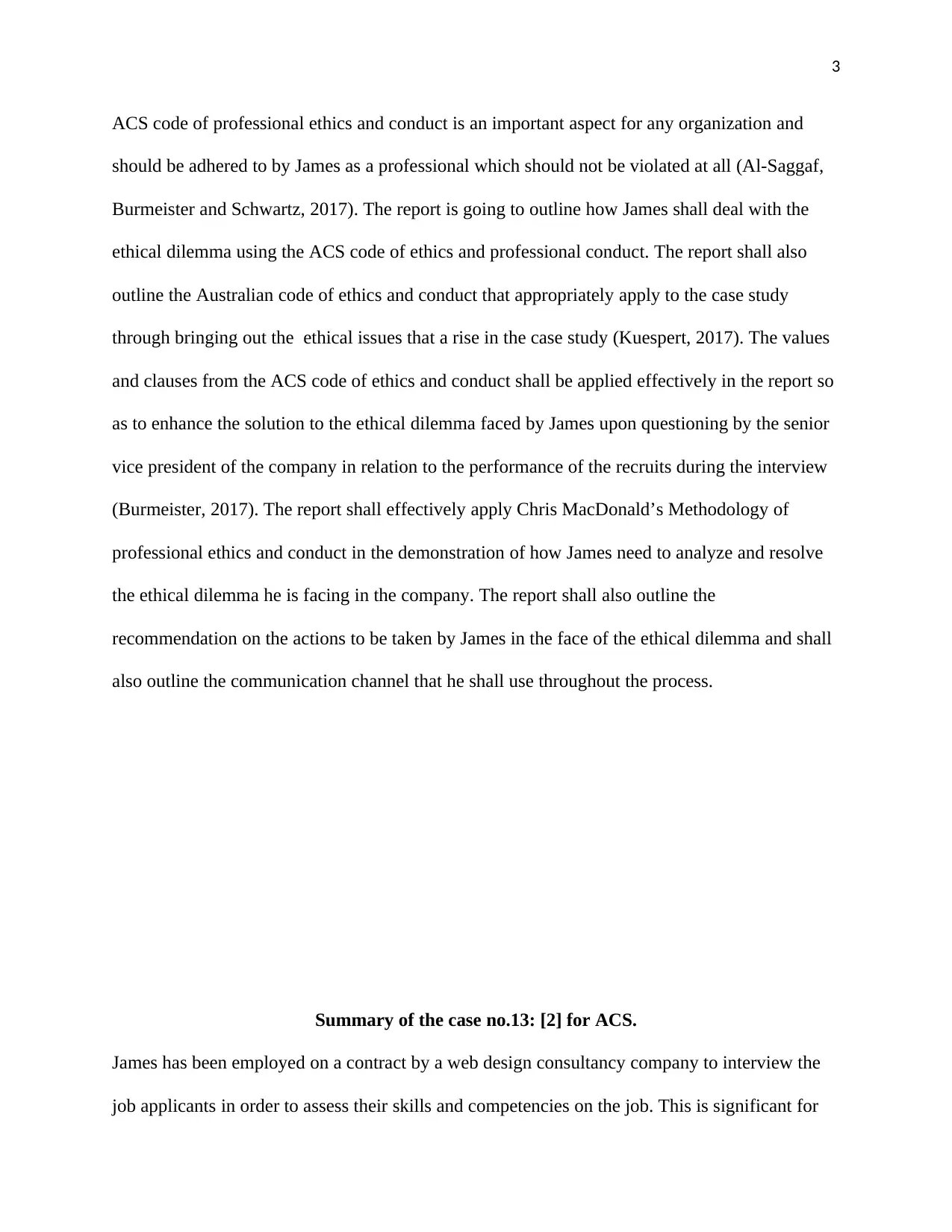
3
ACS code of professional ethics and conduct is an important aspect for any organization and
should be adhered to by James as a professional which should not be violated at all (Al-Saggaf,
Burmeister and Schwartz, 2017). The report is going to outline how James shall deal with the
ethical dilemma using the ACS code of ethics and professional conduct. The report shall also
outline the Australian code of ethics and conduct that appropriately apply to the case study
through bringing out the ethical issues that a rise in the case study (Kuespert, 2017). The values
and clauses from the ACS code of ethics and conduct shall be applied effectively in the report so
as to enhance the solution to the ethical dilemma faced by James upon questioning by the senior
vice president of the company in relation to the performance of the recruits during the interview
(Burmeister, 2017). The report shall effectively apply Chris MacDonald’s Methodology of
professional ethics and conduct in the demonstration of how James need to analyze and resolve
the ethical dilemma he is facing in the company. The report shall also outline the
recommendation on the actions to be taken by James in the face of the ethical dilemma and shall
also outline the communication channel that he shall use throughout the process.
Summary of the case no.13: [2] for ACS.
James has been employed on a contract by a web design consultancy company to interview the
job applicants in order to assess their skills and competencies on the job. This is significant for
ACS code of professional ethics and conduct is an important aspect for any organization and
should be adhered to by James as a professional which should not be violated at all (Al-Saggaf,
Burmeister and Schwartz, 2017). The report is going to outline how James shall deal with the
ethical dilemma using the ACS code of ethics and professional conduct. The report shall also
outline the Australian code of ethics and conduct that appropriately apply to the case study
through bringing out the ethical issues that a rise in the case study (Kuespert, 2017). The values
and clauses from the ACS code of ethics and conduct shall be applied effectively in the report so
as to enhance the solution to the ethical dilemma faced by James upon questioning by the senior
vice president of the company in relation to the performance of the recruits during the interview
(Burmeister, 2017). The report shall effectively apply Chris MacDonald’s Methodology of
professional ethics and conduct in the demonstration of how James need to analyze and resolve
the ethical dilemma he is facing in the company. The report shall also outline the
recommendation on the actions to be taken by James in the face of the ethical dilemma and shall
also outline the communication channel that he shall use throughout the process.
Summary of the case no.13: [2] for ACS.
James has been employed on a contract by a web design consultancy company to interview the
job applicants in order to assess their skills and competencies on the job. This is significant for
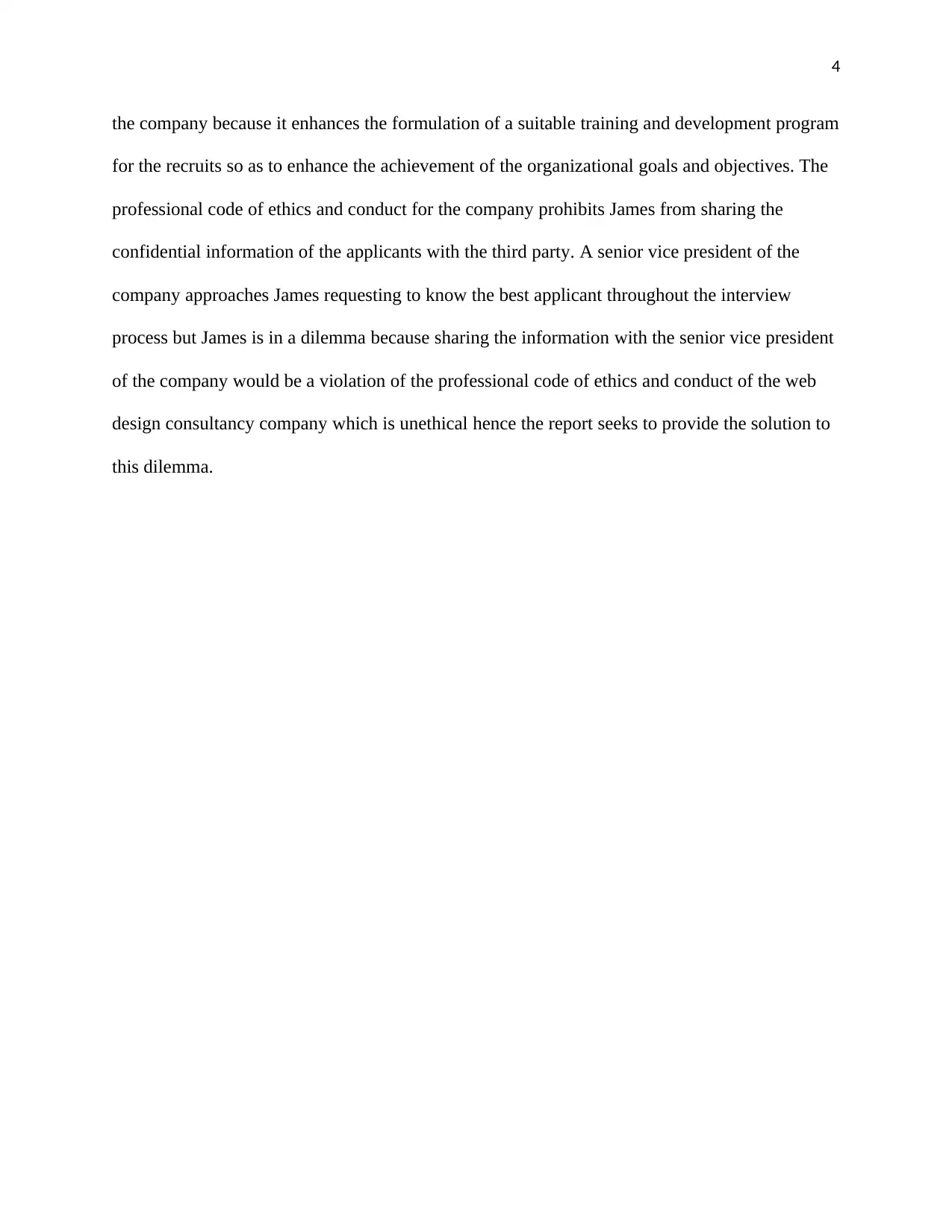
4
the company because it enhances the formulation of a suitable training and development program
for the recruits so as to enhance the achievement of the organizational goals and objectives. The
professional code of ethics and conduct for the company prohibits James from sharing the
confidential information of the applicants with the third party. A senior vice president of the
company approaches James requesting to know the best applicant throughout the interview
process but James is in a dilemma because sharing the information with the senior vice president
of the company would be a violation of the professional code of ethics and conduct of the web
design consultancy company which is unethical hence the report seeks to provide the solution to
this dilemma.
the company because it enhances the formulation of a suitable training and development program
for the recruits so as to enhance the achievement of the organizational goals and objectives. The
professional code of ethics and conduct for the company prohibits James from sharing the
confidential information of the applicants with the third party. A senior vice president of the
company approaches James requesting to know the best applicant throughout the interview
process but James is in a dilemma because sharing the information with the senior vice president
of the company would be a violation of the professional code of ethics and conduct of the web
design consultancy company which is unethical hence the report seeks to provide the solution to
this dilemma.
Secure Best Marks with AI Grader
Need help grading? Try our AI Grader for instant feedback on your assignments.
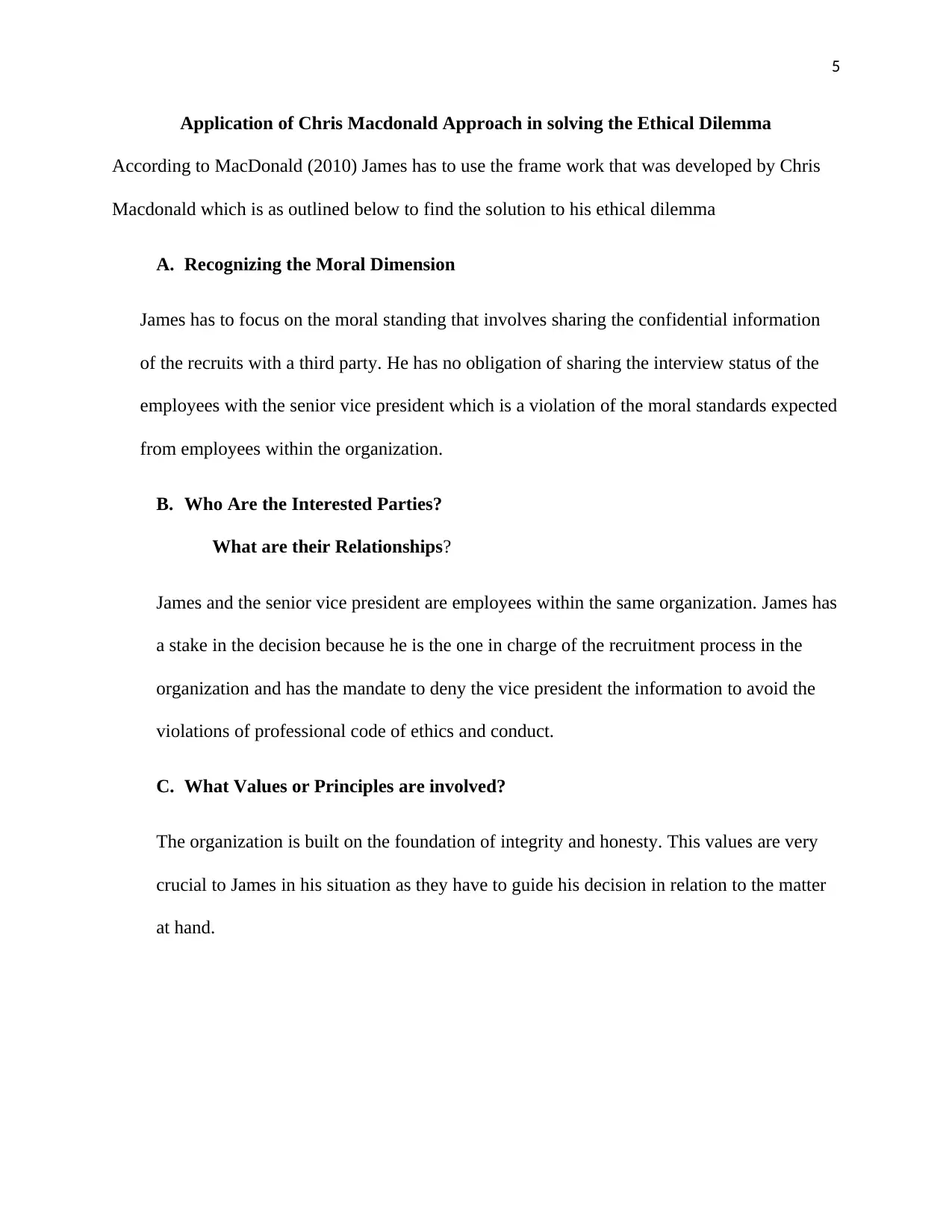
5
Application of Chris Macdonald Approach in solving the Ethical Dilemma
According to MacDonald (2010) James has to use the frame work that was developed by Chris
Macdonald which is as outlined below to find the solution to his ethical dilemma
A. Recognizing the Moral Dimension
James has to focus on the moral standing that involves sharing the confidential information
of the recruits with a third party. He has no obligation of sharing the interview status of the
employees with the senior vice president which is a violation of the moral standards expected
from employees within the organization.
B. Who Are the Interested Parties?
What are their Relationships?
James and the senior vice president are employees within the same organization. James has
a stake in the decision because he is the one in charge of the recruitment process in the
organization and has the mandate to deny the vice president the information to avoid the
violations of professional code of ethics and conduct.
C. What Values or Principles are involved?
The organization is built on the foundation of integrity and honesty. This values are very
crucial to James in his situation as they have to guide his decision in relation to the matter
at hand.
Application of Chris Macdonald Approach in solving the Ethical Dilemma
According to MacDonald (2010) James has to use the frame work that was developed by Chris
Macdonald which is as outlined below to find the solution to his ethical dilemma
A. Recognizing the Moral Dimension
James has to focus on the moral standing that involves sharing the confidential information
of the recruits with a third party. He has no obligation of sharing the interview status of the
employees with the senior vice president which is a violation of the moral standards expected
from employees within the organization.
B. Who Are the Interested Parties?
What are their Relationships?
James and the senior vice president are employees within the same organization. James has
a stake in the decision because he is the one in charge of the recruitment process in the
organization and has the mandate to deny the vice president the information to avoid the
violations of professional code of ethics and conduct.
C. What Values or Principles are involved?
The organization is built on the foundation of integrity and honesty. This values are very
crucial to James in his situation as they have to guide his decision in relation to the matter
at hand.

6
Is there a question of trust?
James has to maintain the trust bestowed upon him by the organization in relation to the
confidential information of the employees.
Is personal autonomy a consideration?
James has to be determined in his choice as far as professional code of ethics and conduct is
concerned.
Is there a question of fairness?
James will be acting on a fair ground when he refuses to share the confidential information of the
applicants with the senior vice president because the professional code of ethics cuts across all
the employees within the organization despite of the status.
Is anyone to be harmed or helped?
The decision to withhold the information from the senior vice president might not harm anyone
but will be helpful because it shall create an emphasis on the significance of adhering to
professional code of ethics and conduct within the organization.
D. Sketch out options -- not just actions, but courses of action.
James have various alternatives for the senior vice president, he can request him to be
patient till the successful candidate is announced officially by the Human resource
manager or he should request to be part of the recruitment during the next recruitment in
order to obtain all the information he may desire to know.
Is there a question of trust?
James has to maintain the trust bestowed upon him by the organization in relation to the
confidential information of the employees.
Is personal autonomy a consideration?
James has to be determined in his choice as far as professional code of ethics and conduct is
concerned.
Is there a question of fairness?
James will be acting on a fair ground when he refuses to share the confidential information of the
applicants with the senior vice president because the professional code of ethics cuts across all
the employees within the organization despite of the status.
Is anyone to be harmed or helped?
The decision to withhold the information from the senior vice president might not harm anyone
but will be helpful because it shall create an emphasis on the significance of adhering to
professional code of ethics and conduct within the organization.
D. Sketch out options -- not just actions, but courses of action.
James have various alternatives for the senior vice president, he can request him to be
patient till the successful candidate is announced officially by the Human resource
manager or he should request to be part of the recruitment during the next recruitment in
order to obtain all the information he may desire to know.
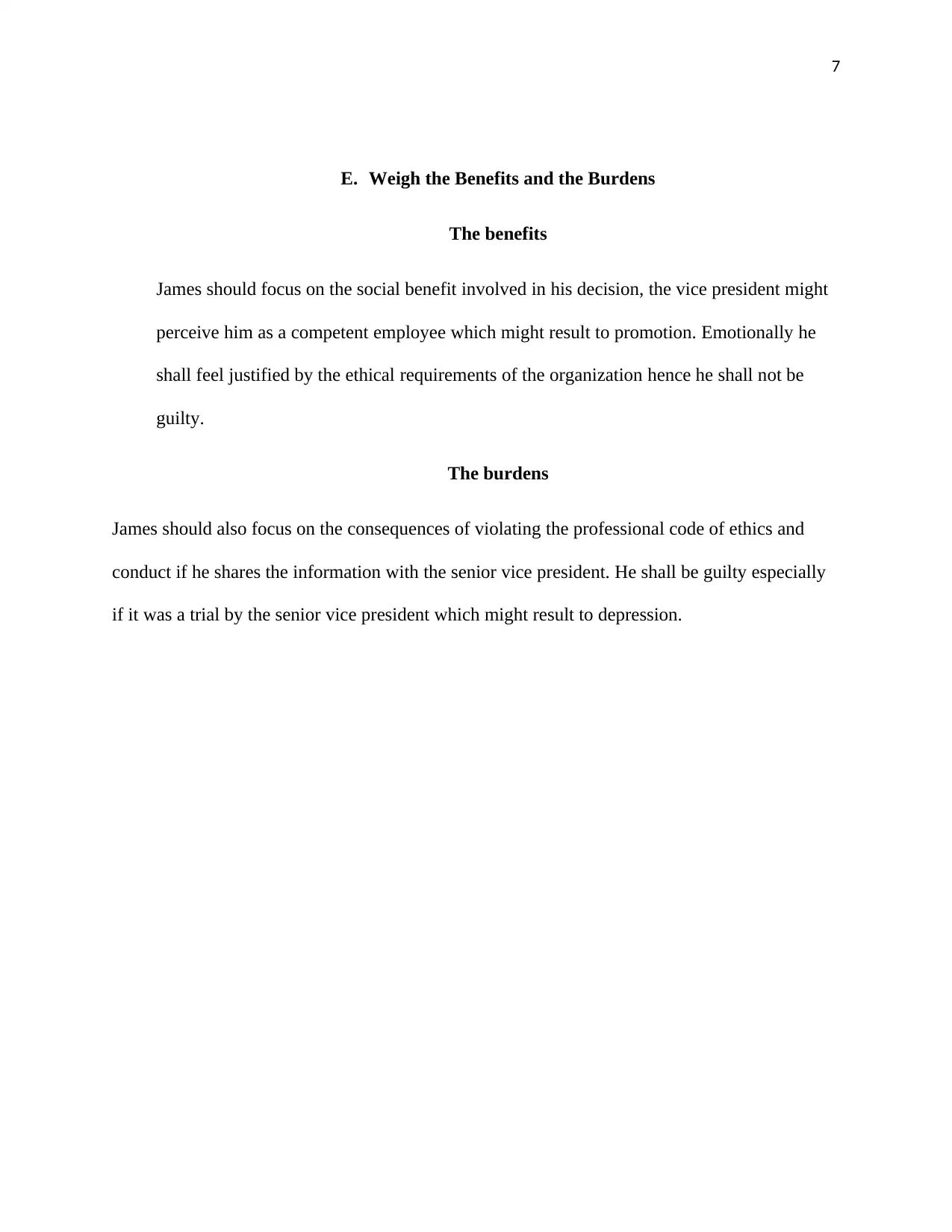
7
E. Weigh the Benefits and the Burdens
The benefits
James should focus on the social benefit involved in his decision, the vice president might
perceive him as a competent employee which might result to promotion. Emotionally he
shall feel justified by the ethical requirements of the organization hence he shall not be
guilty.
The burdens
James should also focus on the consequences of violating the professional code of ethics and
conduct if he shares the information with the senior vice president. He shall be guilty especially
if it was a trial by the senior vice president which might result to depression.
E. Weigh the Benefits and the Burdens
The benefits
James should focus on the social benefit involved in his decision, the vice president might
perceive him as a competent employee which might result to promotion. Emotionally he
shall feel justified by the ethical requirements of the organization hence he shall not be
guilty.
The burdens
James should also focus on the consequences of violating the professional code of ethics and
conduct if he shares the information with the senior vice president. He shall be guilty especially
if it was a trial by the senior vice president which might result to depression.
Paraphrase This Document
Need a fresh take? Get an instant paraphrase of this document with our AI Paraphraser
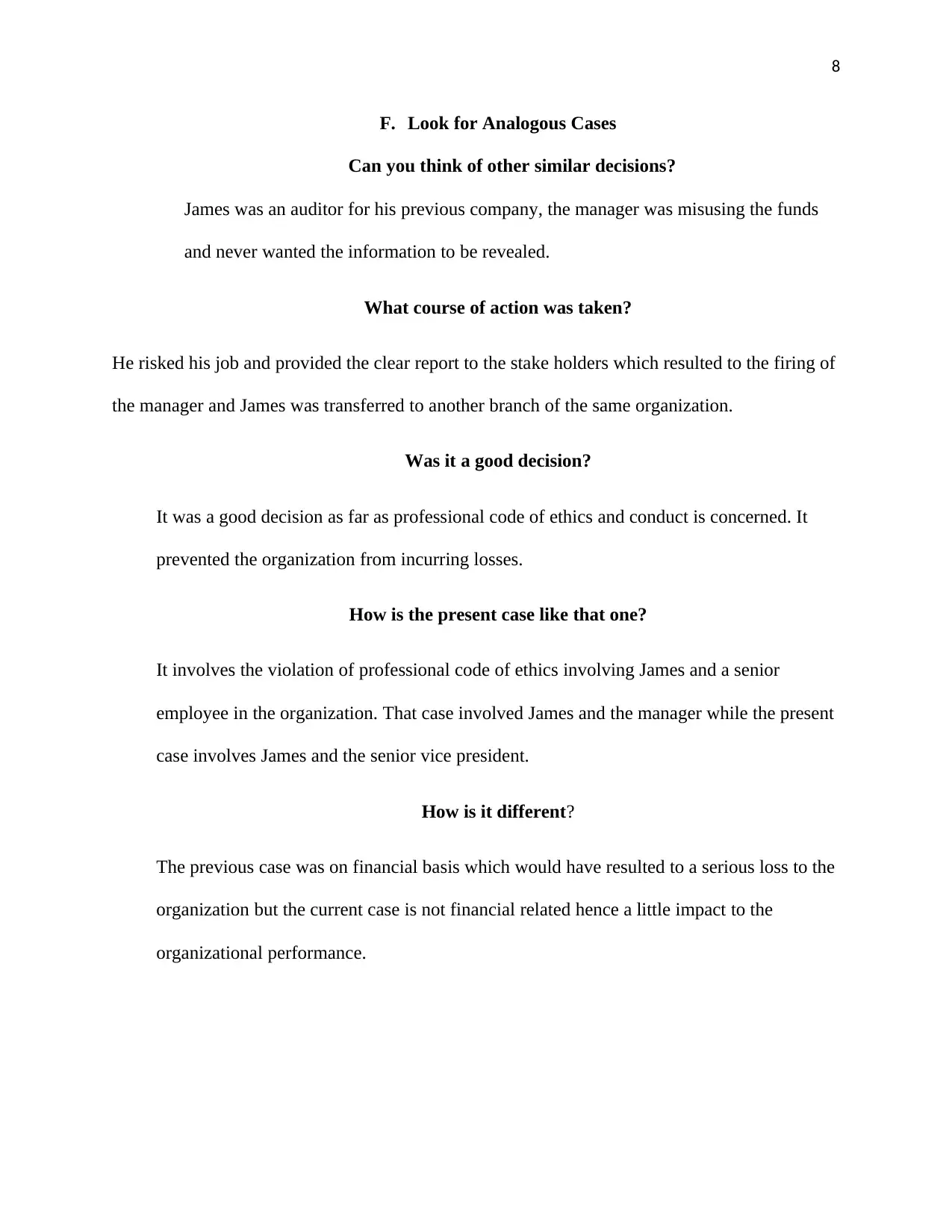
8
F. Look for Analogous Cases
Can you think of other similar decisions?
James was an auditor for his previous company, the manager was misusing the funds
and never wanted the information to be revealed.
What course of action was taken?
He risked his job and provided the clear report to the stake holders which resulted to the firing of
the manager and James was transferred to another branch of the same organization.
Was it a good decision?
It was a good decision as far as professional code of ethics and conduct is concerned. It
prevented the organization from incurring losses.
How is the present case like that one?
It involves the violation of professional code of ethics involving James and a senior
employee in the organization. That case involved James and the manager while the present
case involves James and the senior vice president.
How is it different?
The previous case was on financial basis which would have resulted to a serious loss to the
organization but the current case is not financial related hence a little impact to the
organizational performance.
F. Look for Analogous Cases
Can you think of other similar decisions?
James was an auditor for his previous company, the manager was misusing the funds
and never wanted the information to be revealed.
What course of action was taken?
He risked his job and provided the clear report to the stake holders which resulted to the firing of
the manager and James was transferred to another branch of the same organization.
Was it a good decision?
It was a good decision as far as professional code of ethics and conduct is concerned. It
prevented the organization from incurring losses.
How is the present case like that one?
It involves the violation of professional code of ethics involving James and a senior
employee in the organization. That case involved James and the manager while the present
case involves James and the senior vice president.
How is it different?
The previous case was on financial basis which would have resulted to a serious loss to the
organization but the current case is not financial related hence a little impact to the
organizational performance.
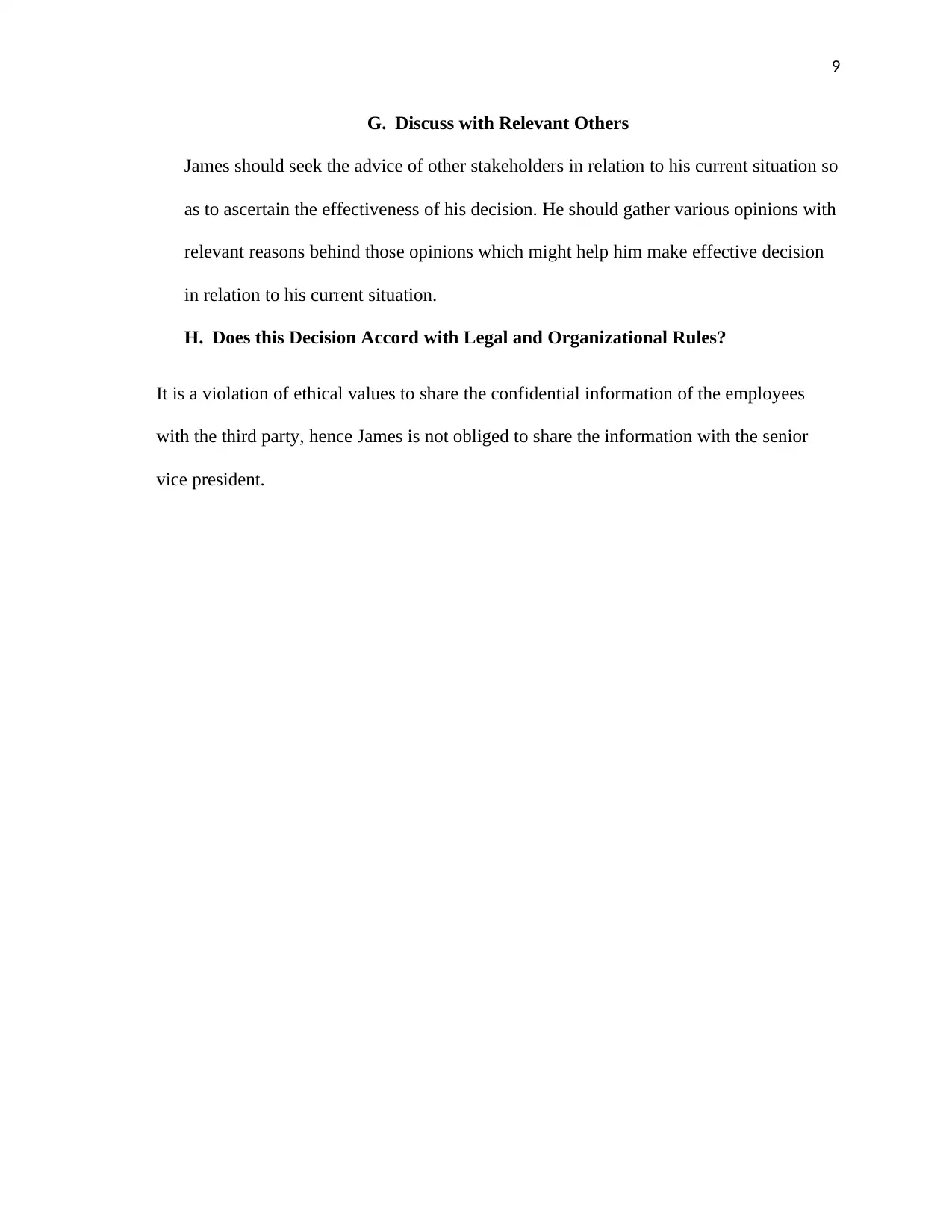
9
G. Discuss with Relevant Others
James should seek the advice of other stakeholders in relation to his current situation so
as to ascertain the effectiveness of his decision. He should gather various opinions with
relevant reasons behind those opinions which might help him make effective decision
in relation to his current situation.
H. Does this Decision Accord with Legal and Organizational Rules?
It is a violation of ethical values to share the confidential information of the employees
with the third party, hence James is not obliged to share the information with the senior
vice president.
G. Discuss with Relevant Others
James should seek the advice of other stakeholders in relation to his current situation so
as to ascertain the effectiveness of his decision. He should gather various opinions with
relevant reasons behind those opinions which might help him make effective decision
in relation to his current situation.
H. Does this Decision Accord with Legal and Organizational Rules?
It is a violation of ethical values to share the confidential information of the employees
with the third party, hence James is not obliged to share the information with the senior
vice president.
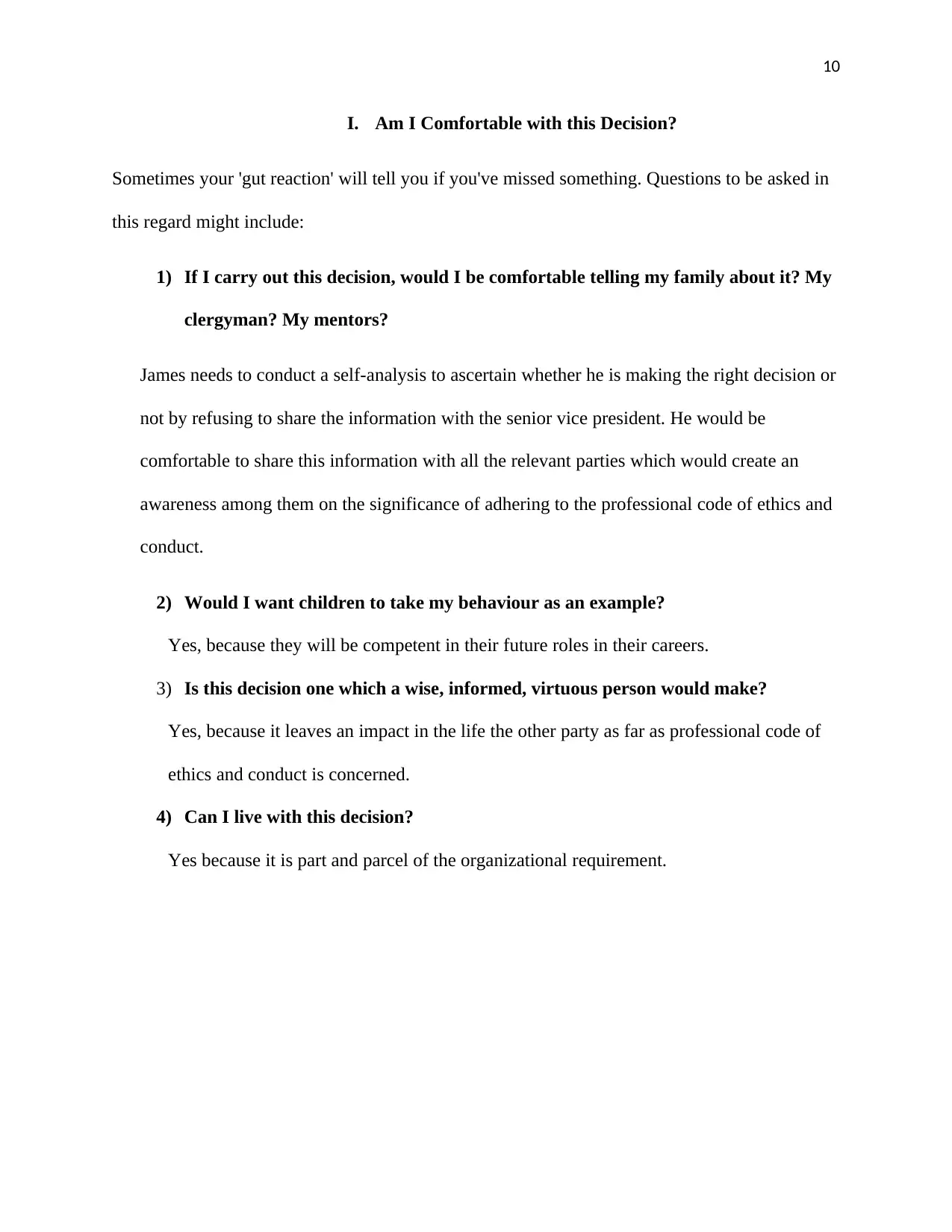
10
I. Am I Comfortable with this Decision?
Sometimes your 'gut reaction' will tell you if you've missed something. Questions to be asked in
this regard might include:
1) If I carry out this decision, would I be comfortable telling my family about it? My
clergyman? My mentors?
James needs to conduct a self-analysis to ascertain whether he is making the right decision or
not by refusing to share the information with the senior vice president. He would be
comfortable to share this information with all the relevant parties which would create an
awareness among them on the significance of adhering to the professional code of ethics and
conduct.
2) Would I want children to take my behaviour as an example?
Yes, because they will be competent in their future roles in their careers.
3) Is this decision one which a wise, informed, virtuous person would make?
Yes, because it leaves an impact in the life the other party as far as professional code of
ethics and conduct is concerned.
4) Can I live with this decision?
Yes because it is part and parcel of the organizational requirement.
I. Am I Comfortable with this Decision?
Sometimes your 'gut reaction' will tell you if you've missed something. Questions to be asked in
this regard might include:
1) If I carry out this decision, would I be comfortable telling my family about it? My
clergyman? My mentors?
James needs to conduct a self-analysis to ascertain whether he is making the right decision or
not by refusing to share the information with the senior vice president. He would be
comfortable to share this information with all the relevant parties which would create an
awareness among them on the significance of adhering to the professional code of ethics and
conduct.
2) Would I want children to take my behaviour as an example?
Yes, because they will be competent in their future roles in their careers.
3) Is this decision one which a wise, informed, virtuous person would make?
Yes, because it leaves an impact in the life the other party as far as professional code of
ethics and conduct is concerned.
4) Can I live with this decision?
Yes because it is part and parcel of the organizational requirement.
Secure Best Marks with AI Grader
Need help grading? Try our AI Grader for instant feedback on your assignments.
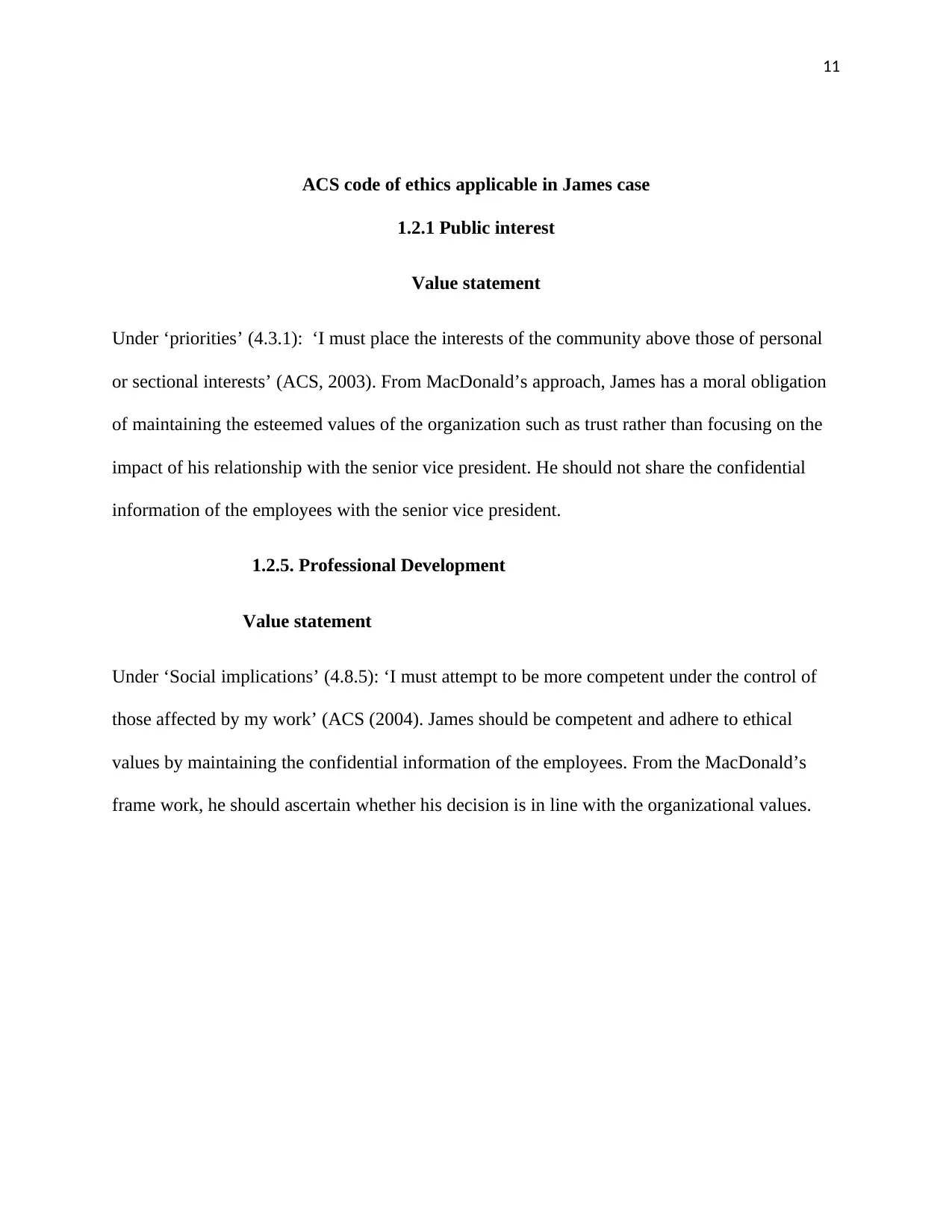
11
ACS code of ethics applicable in James case
1.2.1 Public interest
Value statement
Under ‘priorities’ (4.3.1): ‘I must place the interests of the community above those of personal
or sectional interests’ (ACS, 2003). From MacDonald’s approach, James has a moral obligation
of maintaining the esteemed values of the organization such as trust rather than focusing on the
impact of his relationship with the senior vice president. He should not share the confidential
information of the employees with the senior vice president.
1.2.5. Professional Development
Value statement
Under ‘Social implications’ (4.8.5): ‘I must attempt to be more competent under the control of
those affected by my work’ (ACS (2004). James should be competent and adhere to ethical
values by maintaining the confidential information of the employees. From the MacDonald’s
frame work, he should ascertain whether his decision is in line with the organizational values.
ACS code of ethics applicable in James case
1.2.1 Public interest
Value statement
Under ‘priorities’ (4.3.1): ‘I must place the interests of the community above those of personal
or sectional interests’ (ACS, 2003). From MacDonald’s approach, James has a moral obligation
of maintaining the esteemed values of the organization such as trust rather than focusing on the
impact of his relationship with the senior vice president. He should not share the confidential
information of the employees with the senior vice president.
1.2.5. Professional Development
Value statement
Under ‘Social implications’ (4.8.5): ‘I must attempt to be more competent under the control of
those affected by my work’ (ACS (2004). James should be competent and adhere to ethical
values by maintaining the confidential information of the employees. From the MacDonald’s
frame work, he should ascertain whether his decision is in line with the organizational values.

12
1.2.6 Professionalism.
Value statement
Under ‘social implications’ (4.8.6): ‘I must not require, or attempt to influence, any person to
take any action which would involve a breach of the code of Ethics’. James should inform the
vice president that he should adhere to the value statement and wait for the results of the
recruitment. This would enable him to be comfortable with his final decision on the issue as per
the MacDonald’s frame work.
1.2.6 Professionalism.
Value statement
Under ‘social implications’ (4.8.6): ‘I must not require, or attempt to influence, any person to
take any action which would involve a breach of the code of Ethics’. James should inform the
vice president that he should adhere to the value statement and wait for the results of the
recruitment. This would enable him to be comfortable with his final decision on the issue as per
the MacDonald’s frame work.

13
Clauses from the ACS code of professional conduct
1.2.1(g)-‘endeavor to preserve the confidentiality and privacy of the
information of others’. James should not share the confidential information
of the employees with the senior vice president (Leicester, 2016).
1.2.5(b)-‘Increase your awareness of issues affecting the profession and its
relationship with the public’. James should inform the management on the
significance of adhering to the professional code of conduct.
1.2.6(f)-‘refrain from any conduct or action in your professional role which
may tarnish the image of the profession or detract from the good name of the
ACS’.James should refrain from sharing the confidential information of the
employees with the senior vice president (Peterson, 2013).
1.2.6(i)-‘Have pride in your profession, and protect and promote
professionalism and trustworthiness in ICT. James should proud of his office
and make the senior vice president adhere to the rules and regulations
pertaining the office.
1.2.4(c) - ‘Make yourself aware of relevant standards and legislation, and act
accordingly’. James should have a thorough understanding of the regulations
and avoid violating them as per MacDonald’s frame work.
Clauses from the ACS code of professional conduct
1.2.1(g)-‘endeavor to preserve the confidentiality and privacy of the
information of others’. James should not share the confidential information
of the employees with the senior vice president (Leicester, 2016).
1.2.5(b)-‘Increase your awareness of issues affecting the profession and its
relationship with the public’. James should inform the management on the
significance of adhering to the professional code of conduct.
1.2.6(f)-‘refrain from any conduct or action in your professional role which
may tarnish the image of the profession or detract from the good name of the
ACS’.James should refrain from sharing the confidential information of the
employees with the senior vice president (Peterson, 2013).
1.2.6(i)-‘Have pride in your profession, and protect and promote
professionalism and trustworthiness in ICT. James should proud of his office
and make the senior vice president adhere to the rules and regulations
pertaining the office.
1.2.4(c) - ‘Make yourself aware of relevant standards and legislation, and act
accordingly’. James should have a thorough understanding of the regulations
and avoid violating them as per MacDonald’s frame work.
Paraphrase This Document
Need a fresh take? Get an instant paraphrase of this document with our AI Paraphraser
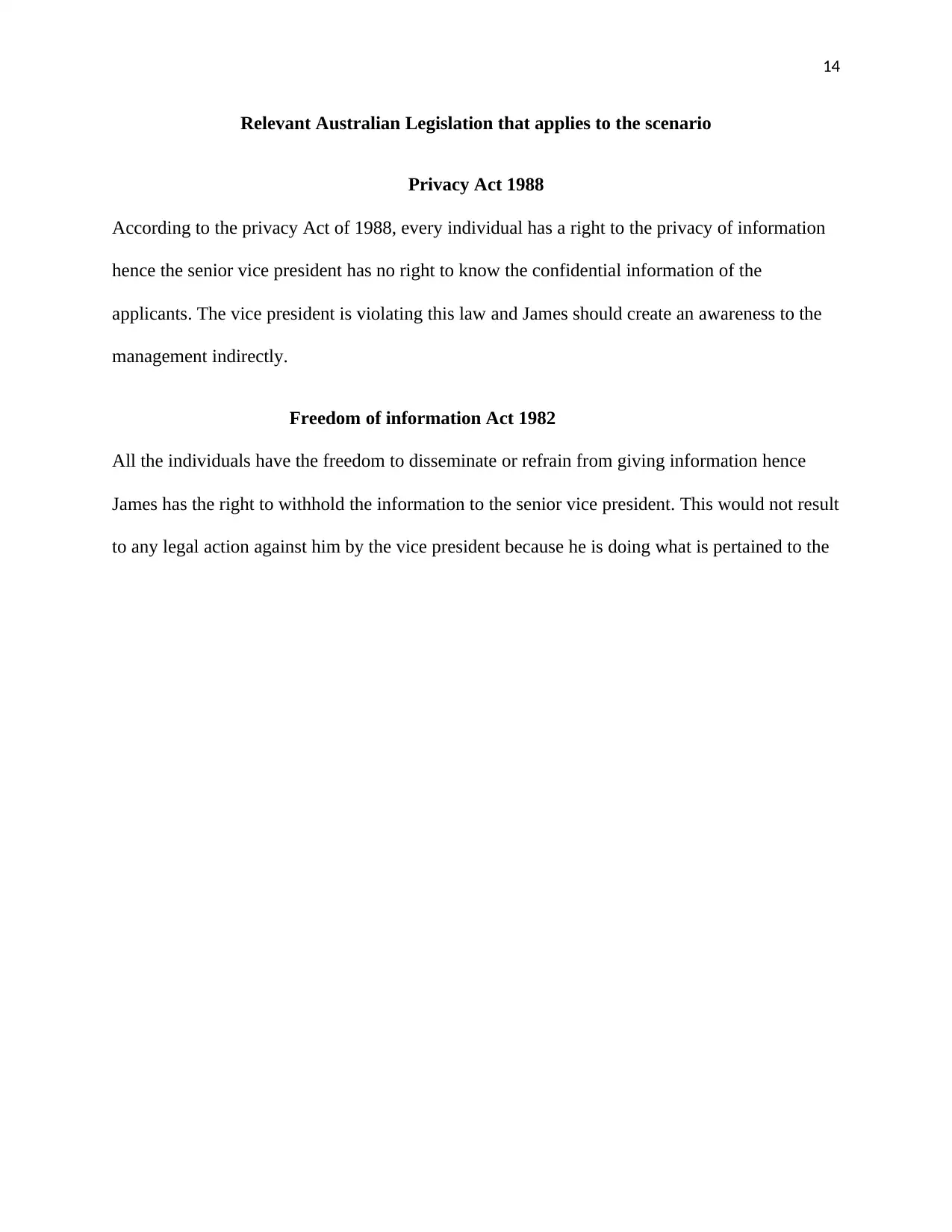
14
Relevant Australian Legislation that applies to the scenario
Privacy Act 1988
According to the privacy Act of 1988, every individual has a right to the privacy of information
hence the senior vice president has no right to know the confidential information of the
applicants. The vice president is violating this law and James should create an awareness to the
management indirectly.
Freedom of information Act 1982
All the individuals have the freedom to disseminate or refrain from giving information hence
James has the right to withhold the information to the senior vice president. This would not result
to any legal action against him by the vice president because he is doing what is pertained to the
Relevant Australian Legislation that applies to the scenario
Privacy Act 1988
According to the privacy Act of 1988, every individual has a right to the privacy of information
hence the senior vice president has no right to know the confidential information of the
applicants. The vice president is violating this law and James should create an awareness to the
management indirectly.
Freedom of information Act 1982
All the individuals have the freedom to disseminate or refrain from giving information hence
James has the right to withhold the information to the senior vice president. This would not result
to any legal action against him by the vice president because he is doing what is pertained to the
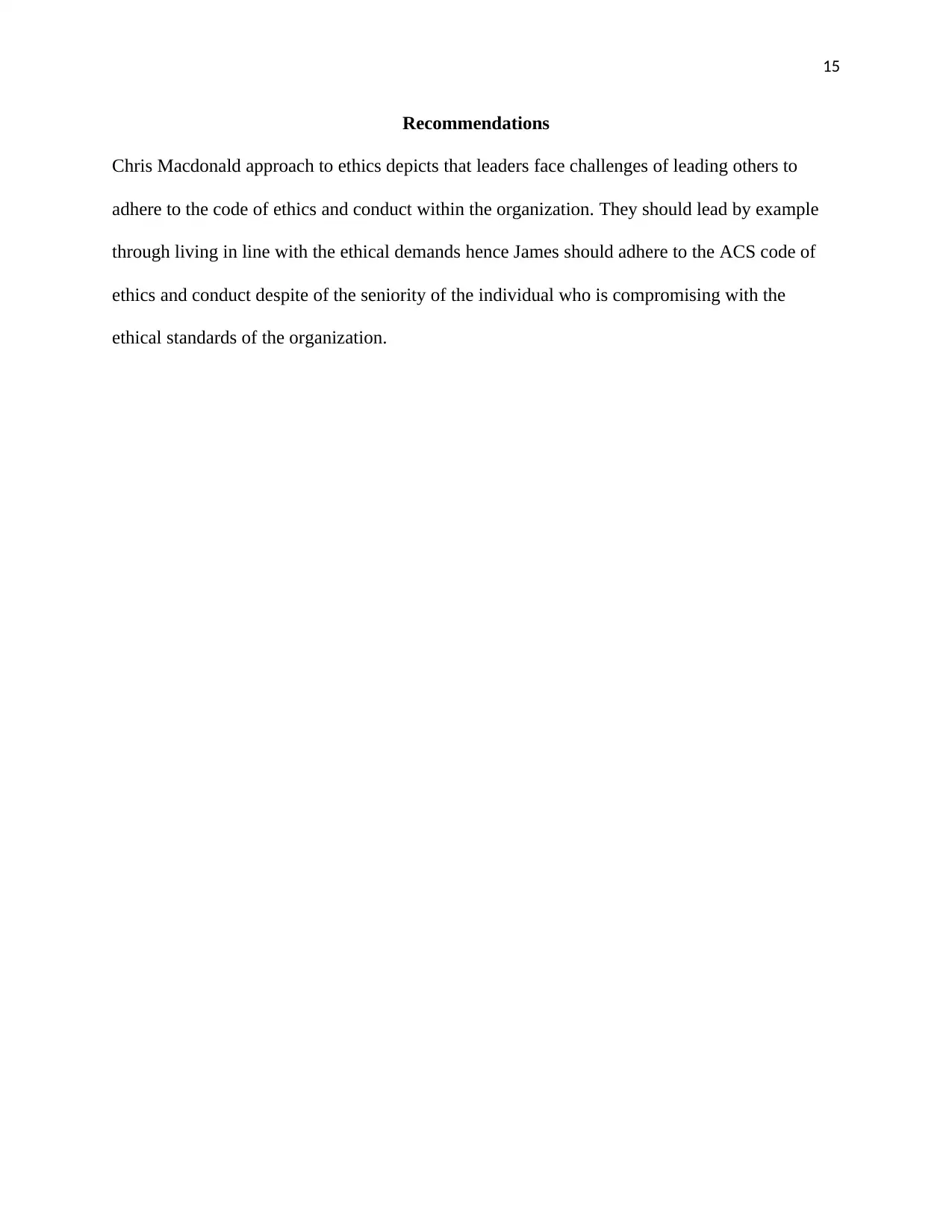
15
Recommendations
Chris Macdonald approach to ethics depicts that leaders face challenges of leading others to
adhere to the code of ethics and conduct within the organization. They should lead by example
through living in line with the ethical demands hence James should adhere to the ACS code of
ethics and conduct despite of the seniority of the individual who is compromising with the
ethical standards of the organization.
Recommendations
Chris Macdonald approach to ethics depicts that leaders face challenges of leading others to
adhere to the code of ethics and conduct within the organization. They should lead by example
through living in line with the ethical demands hence James should adhere to the ACS code of
ethics and conduct despite of the seniority of the individual who is compromising with the
ethical standards of the organization.
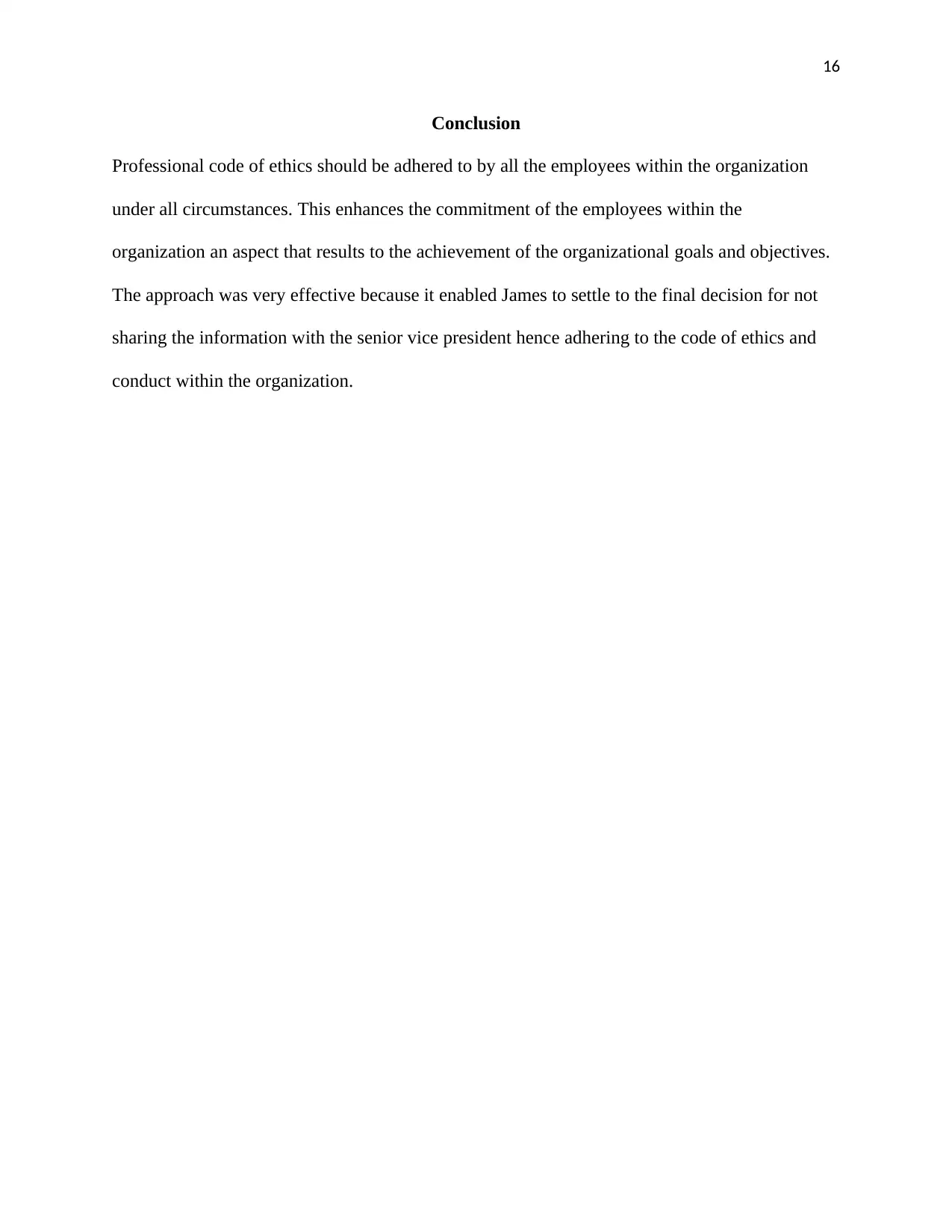
16
Conclusion
Professional code of ethics should be adhered to by all the employees within the organization
under all circumstances. This enhances the commitment of the employees within the
organization an aspect that results to the achievement of the organizational goals and objectives.
The approach was very effective because it enabled James to settle to the final decision for not
sharing the information with the senior vice president hence adhering to the code of ethics and
conduct within the organization.
Conclusion
Professional code of ethics should be adhered to by all the employees within the organization
under all circumstances. This enhances the commitment of the employees within the
organization an aspect that results to the achievement of the organizational goals and objectives.
The approach was very effective because it enabled James to settle to the final decision for not
sharing the information with the senior vice president hence adhering to the code of ethics and
conduct within the organization.
Secure Best Marks with AI Grader
Need help grading? Try our AI Grader for instant feedback on your assignments.
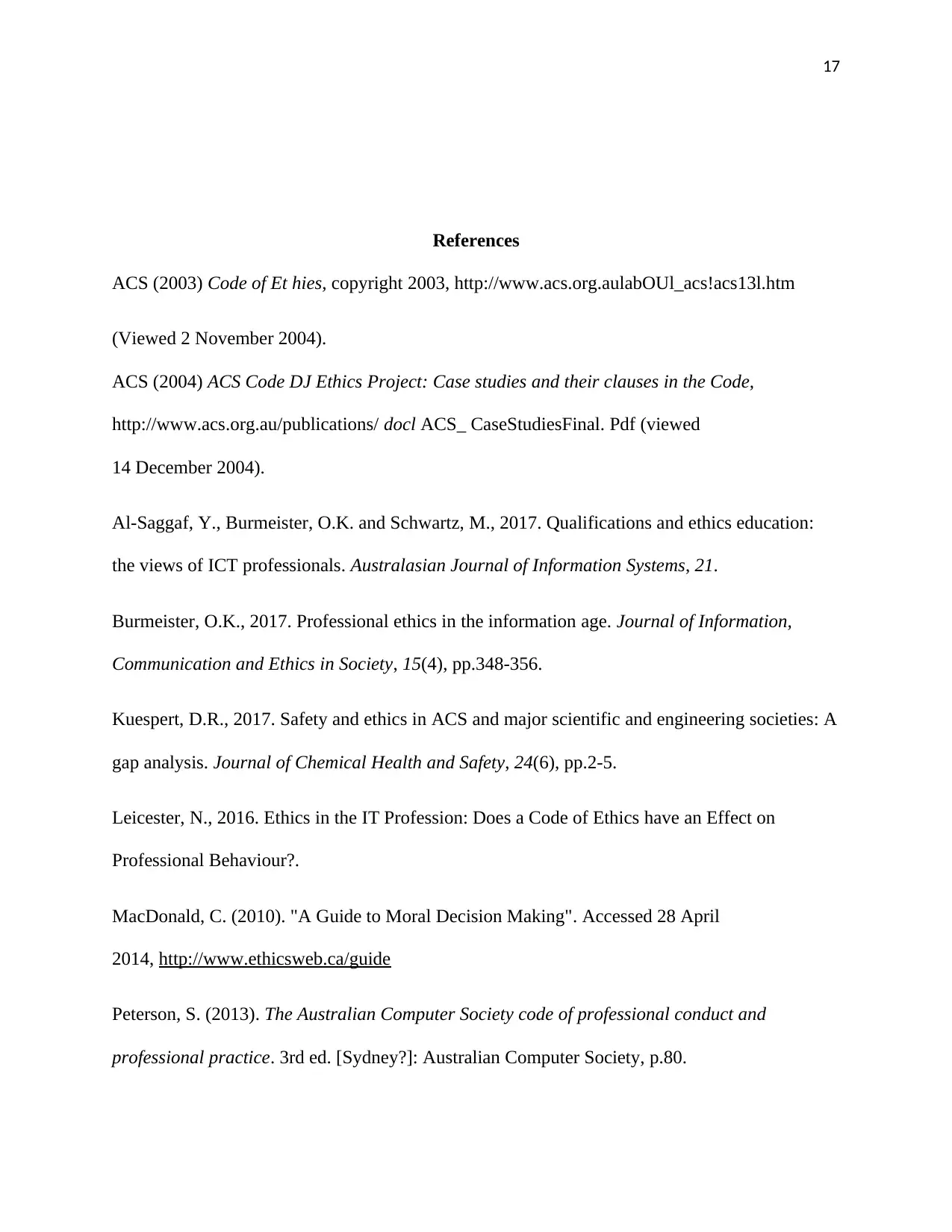
17
References
ACS (2003) Code of Et hies, copyright 2003, http://www.acs.org.aulabOUl_acs!acs13l.htm
(Viewed 2 November 2004).
ACS (2004) ACS Code DJ Ethics Project: Case studies and their clauses in the Code,
http://www.acs.org.au/publications/ docl ACS_ CaseStudiesFinal. Pdf (viewed
14 December 2004).
Al-Saggaf, Y., Burmeister, O.K. and Schwartz, M., 2017. Qualifications and ethics education:
the views of ICT professionals. Australasian Journal of Information Systems, 21.
Burmeister, O.K., 2017. Professional ethics in the information age. Journal of Information,
Communication and Ethics in Society, 15(4), pp.348-356.
Kuespert, D.R., 2017. Safety and ethics in ACS and major scientific and engineering societies: A
gap analysis. Journal of Chemical Health and Safety, 24(6), pp.2-5.
Leicester, N., 2016. Ethics in the IT Profession: Does a Code of Ethics have an Effect on
Professional Behaviour?.
MacDonald, C. (2010). "A Guide to Moral Decision Making". Accessed 28 April
2014, http://www.ethicsweb.ca/guide
Peterson, S. (2013). The Australian Computer Society code of professional conduct and
professional practice. 3rd ed. [Sydney?]: Australian Computer Society, p.80.
References
ACS (2003) Code of Et hies, copyright 2003, http://www.acs.org.aulabOUl_acs!acs13l.htm
(Viewed 2 November 2004).
ACS (2004) ACS Code DJ Ethics Project: Case studies and their clauses in the Code,
http://www.acs.org.au/publications/ docl ACS_ CaseStudiesFinal. Pdf (viewed
14 December 2004).
Al-Saggaf, Y., Burmeister, O.K. and Schwartz, M., 2017. Qualifications and ethics education:
the views of ICT professionals. Australasian Journal of Information Systems, 21.
Burmeister, O.K., 2017. Professional ethics in the information age. Journal of Information,
Communication and Ethics in Society, 15(4), pp.348-356.
Kuespert, D.R., 2017. Safety and ethics in ACS and major scientific and engineering societies: A
gap analysis. Journal of Chemical Health and Safety, 24(6), pp.2-5.
Leicester, N., 2016. Ethics in the IT Profession: Does a Code of Ethics have an Effect on
Professional Behaviour?.
MacDonald, C. (2010). "A Guide to Moral Decision Making". Accessed 28 April
2014, http://www.ethicsweb.ca/guide
Peterson, S. (2013). The Australian Computer Society code of professional conduct and
professional practice. 3rd ed. [Sydney?]: Australian Computer Society, p.80.

18
1 out of 18
Related Documents
Your All-in-One AI-Powered Toolkit for Academic Success.
+13062052269
info@desklib.com
Available 24*7 on WhatsApp / Email
![[object Object]](/_next/static/media/star-bottom.7253800d.svg)
Unlock your academic potential
© 2024 | Zucol Services PVT LTD | All rights reserved.





